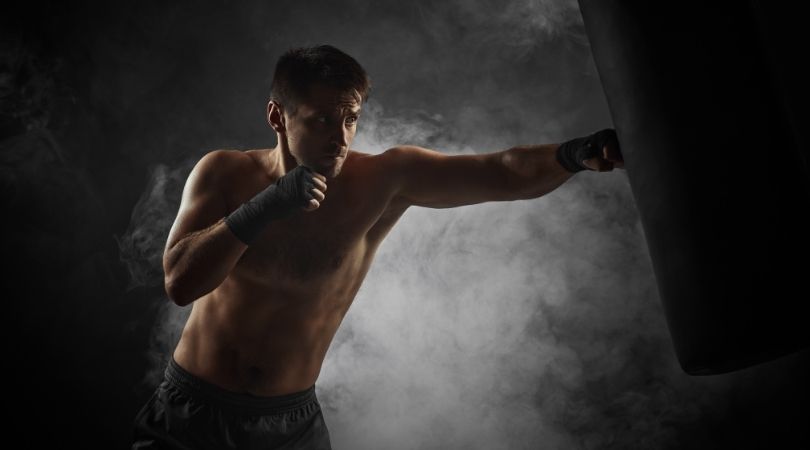
Cross punches, also called straights or rear hand blows, are thrown with the dominant hands. Its name refers to the fact that the punch crosses over the leading arm. There is no doubt that it is a power punch, similar to the uppercut and the hook.
Right straights are generally used to take advantage of prepared positions with strong blows, but we can also use them to set up a counterattack.
From this guide, you will learn what a cross punch is, how to throw a cross in boxing correctly, the typical mistakes and variations, and how to use these straight punches effectively.
How to throw a boxing cross punch properly
Here is a video tutorial to learn the correct technique.
A boxer begins from a basic boxing stance by moving his body forward with his right foot and taking a small step forward to the left with his left foot. Meanwhile, he turns his trunk from right to left and strikes the target with a straight fist.
The left fist secures the front of the face, while the lowered left elbow secures the body at the ribcage. According to the distance to the target, either the right foot remains in place or the trainee slides forward. The body’s entire weight is placed on the left leg, which is slightly bent at the knee. The extended right leg supports, with the heel slightly turned out from the momentum.
At the end of the punching, the left foot returns to the basic stance, and the right hand returns to the starting position at the stroke plane.
Important things to remember
- An effective cross is a defined sequence of movements involving the legs, hips, shoulders, and arms.
- The punch is effective if the fist meets the target when the arm’s elbow goes from extension to flexion.
- Legs and upper body together determine the height of the cross.
- Not only does the left foot provide distance and balance, but it also gives a quick return with enough flexion in the knees.
- Punching and defense should be practiced simultaneously during boxing training.
The most common mistakes with cross punches
- Lifting the knock-out points on the head out of the protection.
- There is a disruption in the synergy of the strike, and a component (leg, hip, shoulder) is missing.
- When the straight cross is delivered, the non-striking hand falls and ceases to defend the chin.
- The forward legs are stretched at the moment of the blow.
- The center of gravity is positioned incorrectly.
- An indicative movement precedes the delivery of a right cross.
- A body’s movement differs from the direction of the hit.
What types of straight punch variations?
There are three ways to use straight to the head during a fight: attacking, preventing, and following.
- An attacking boxing cross punch, which is usually struck without preparation, is a rare attack. It only works when the opponent is caught off guard or in an unprotected situation.
- Preventive crosses are used to prevent an opponent’s action or to break it up.
- The following right hand is always effective after a form of striking.
Cross body punches
Technically, the cross punch to the body is similar to the right straight on the head. It is important to note that the left foot is stepped forward more, the torso is more forward, and the knees are bent to provide the necessary height.
You should bend properly when throwing crosses at the body. By striking the straight punch up or down, you are risking the chance of your face being exposed above your hand, resulting in a counterpunch. For straight punches, the striking fist should always move forward in line with the face.
You can apply the straight to the body to the three tactical forms: attacking, preventing, and following.
FAQ
What is the difference between a jab and a cross?
Crosses are straight punches delivered with the rear hand; jabs are straight punches delivered with your lead hand. This means that right-handers jab with their left hand and cross with their right hand, and vice versa for left-handers. Crosses are generally used to hit hard and powerfully, while jabs are used to keep opponents at bay.
What muscles do cross punches work?
By doing this punch, you raise your heart rate while toning your shoulder, bicep, and tricep muscles. The exercise also strengthens the core and helps slim the waist – two desirable results. Hence, it’s a great exercise to include in your fitness workout.
What is the overhand right?
An overhand punch is a semicircle movement thrown with the rear hand. It can also be a vertical hit. In most cases, it is applied whenever there is a bobbing or slipping movement on the opponent’s part. You can get around your opponent’s guard by throwing overhand rights. With the use of body weight as a starting point for the drop, a lot of power can be delivered when using this technique. It is a valuable technique for any martial arts. Check the tutorial here.
What are the best boxing combinations with crosses?
Here are a few examples that work well, but you can learn more boxing combos here.
1-2-3 (jab-cross-left hook)
1-1-2 (jab-jab-cross)
2-3-2 (right cross-left hook-right cross)
1-2 (jab-right cross)
1-2-3-2 (jab-cross-hook-cross)
Sources
- Mack, Jacob, et al. “Amateur boxer biomechanics and punch force.” ISBS-Conference Proceedings Archive. 2010. – www.mdpi.com
- Kimm, Dennis, and David V. Thiel. “Hand speed measurements in boxing.” Procedia Engineering 112 (2015): 502-506. – www.sciencedirect.com


